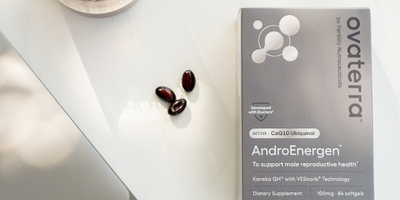What is a normal DHEA level for women? The short answer: It depends on age. Many women who take DHEA to support ovarian health wonder what level of DHEA they should aim for in their blood test results. However, measuring DHEA levels may not be the best way to understand what’s going on with your ovarian health. Doctors measure other hormones, like DHEA-s and testosterone instead. Let’s take a look at why.
Normal DHEA levels by age
DHEA is a weak androgen, produced by the adrenal glands. A small amount is also produced in the ovaries. Though it’s an androgen (male hormone), DHEA has roles in both men and women. DHEA is an intermediate step in steroidogenesis, which is a physiological process that synthesizes sex hormones like testosterone and estrogen from cholesterol. When you take a DHEA supplement, the body converts it mostly into testosterone; a small portion becomes estrogen.
How much DHEA our bodies have changes naturally with age. DHEA levels are low at birth, and rise slowly toward puberty. Then, they rise rapidly to peak at around ages 20-24. From this peak, DHEA levels decline at a rate of about 2-3% a year. Men and women experience the decline of DHEA levels differently: In men, the speed of decline slows down as they age. Women, in contrast, experience a steep initial decline, followed by a plateau. Regardless, women start seeing a steeper decline of DHEA in their mid- to late-30s.
Look at testosterone, rather than DHEA
The fact that DHEA starts its steep decline in our mid- 30s may lead you to think that the decline in DHEA itself is the cause of the drop in fertility rates among women in this age range, but not so fast: Doctors think what matters isn’t necessarily how much DHEA is circulating in the blood. Rather, it’s how much testosterone is present.
Testosterone plays important roles in female bodies. Several small studies, including randomized controlled trials, have suggested that a healthy level of testosterone may be essential to support the health of the ovarian environment where immature eggs develop into ovulation-ready maturity. (This is not to say higher the better; excessive testosterone is harmful to female reproductive health, as in the case of PCOS.)
Several animal studies have suggested a possible explanation. For example, scientists from University of Rochester Medical Center found that a strain of mice without androgen receptors on granulosa cells (the ovarian cells that support and nurture the developing eggs) had lower fertility rates due to disruptions in this egg maturation process. The authors hypothesized that androgens like testosterone may bind to androgen receptors on granulosa cells and promote the normal growth of eggs in the ovaries.
So, when it comes to DHEA and ovarian health, keep your eye on the end product of DHEA: testosterone.
Normal testosterone levels by age
What is a normal testosterone level, then? The answer is surprisingly complicated. First, what’s considered a normal testosterone level for women changes with age, following a similar curve to the normal DHEA levels by age. Furthermore, each laboratory has its own “reference range” for blood test results, because different analytical tools and technologies the labs use can make a significant difference in how much is detected in the blood. And this includes testosterone.
Monitoring DHEA and testosterone levels
What to do, then? Doctors who monitor women on DHEA look at their testosterone levels in relative terms, rather than in absolute numbers. For example, doctors at Center for Human Reproduction, the IVF center where some of the earliest studies on DHEA and female reproductive health were conducted, aims for the upper one-third of each reporting lab’s normal range.
Another reason monitoring DHEA levels isn’t as useful? It’s the fact that DHEA is an intermediate step in steroidogenesis. Because our bodies use DHEA to produce testosterone and other hormones, the level of DHEA fluctuates much more than testosterone. Right after taking a DHEA supplement, the DHEA level rises quickly, then as the body uses it up to produce other hormones like DHEA-s and testosterone, the DHEA level in the blood plummets. This fluctuation makes DHEA a poor indicator to follow, in order to understand what’s really going on. (Learn more about the difference between DHEA and DHEA-s in this post.)
How do I know DHEA is for me?
Similarly, in order to know if DHEA is the right supplement for you, your doctor may test your testosterone (as well as DHEA-s and SHBG), rather than DHEA. As always, discuss with your doctor before you get started on DHEA. If you or your healthcare team have any questions, please reach out. We are with you.














